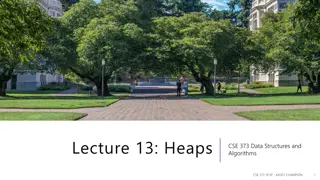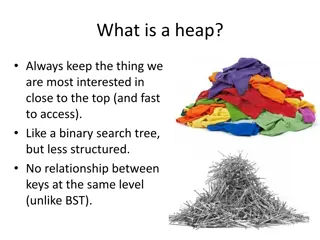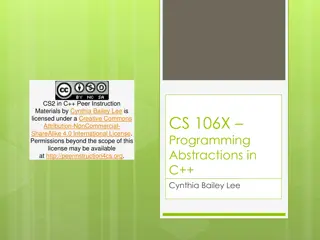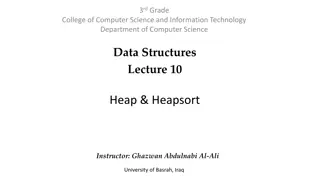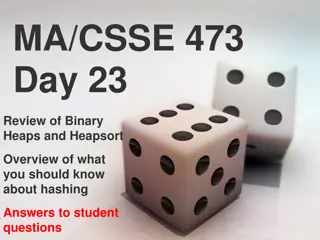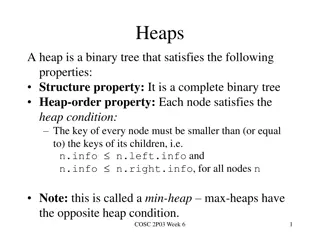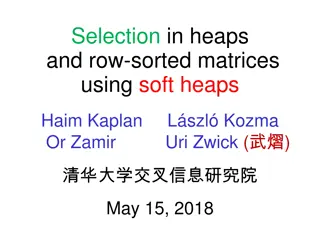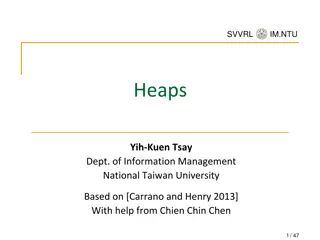Understanding Priority Queues and Heaps in Data Structures
Priority Queues are data structures that support operations like Enqueue, Dequeue, Insert, and deleteMin, where elements are ordered based on priority. This article covers various aspects of Priority Queues, including their implementation, applications in operating systems, and the concept of Binary Heaps, partially ordered trees, and vector representation of complete binary trees.
Download Presentation

Please find below an Image/Link to download the presentation.
The content on the website is provided AS IS for your information and personal use only. It may not be sold, licensed, or shared on other websites without obtaining consent from the author. Download presentation by click this link. If you encounter any issues during the download, it is possible that the publisher has removed the file from their server.
E N D
Presentation Transcript
Priority Queues (Heaps) Sections 6.1 to 6.5 1
Priority Queues Regular queue supports First In, First Out Enqueue(): add a new element Dequeue(): remove oldest element in queue Data structure supports Insert(): add a new element deleteMin(): delete minimum element in priority queue 2
Applications of Priority Queues In Operating Systems Shortest Job First process scheduling In Simulators Scheduling the next event (smallest event time) In essence Any event/job management that assign priority to events/jobs Greedy algorithms Ones that operate by repeatedly finding a minimum 3
Priority Queue Implementation Implemented as adaptor class around Linked lists O(N) worst-case time on either insert() or deleteMin() Binary Search Trees O(log(N)) average time on insert() and delete() Overkill: all elements are sorted, However, we only need the minimum element Repeated deleteMin operations deplete the left subtree(s) Heaps This is what we ll study and use to implement Priority Queues O(logN) worst case for both insertion and delete operations 4
Partially Ordered Trees A partially ordered tree (POT) is a tree T such that: There is an order relation <= defined for the vertices of T For any vertex p and any child c of p, p <= c Consequences: The smallest element in a POT is the root No conclusion can be drawn about the order of children 5
Binary Heaps A binary heap is a partially ordered complete binary tree. The tree is completely filled on all levels except possibly the lowest. 4 root 3 2 1 0 In a more general d-Heap A parent node can have d children We simply refer to binary heaps as heaps 6
Vector Representation of Complete Binary Tree Storing elements in vector in level-order Parent of v[k] = v[k/2] Left child of v[k] = v[2*k] Right child of v[k] = v[2*k + 1] R root l r ll lr rl rr 1 2 3 4 5 6 7 R l r ll lr rl rr 7
Heap example Parent of v[k] = v[k/2] Left child of v[k] = v[2*k] Right child of v[k] = v[2*k + 1] 8
Examples Which one is a heap? 9
Basic Heap Operations: insert(x) Create a hole at next leaf (empty) // Repair upward Repeat Locate parent if POT not satisfied (should x inserted in the hole) Sliding parent element to hole else Stop Insert x into hole 11
Insertion Example: insert(14) (1) (2) (4) (3) 12
Implementation of insert /** * Insert item x, allowing duplicates. */ void insert( const Comparable & x ) { if( currentSize == array.size( ) - 1 ) array.resize( array.size( ) * 2 ); // Percolate up int hole = ++currentSize; Comparable copy = x; array[ 0 ] = std::move( copy ); for( ; x < array[ hole / 2 ]; hole /= 2 ) array[ hole ] = std::move( array[ hole / 2 ] ); array[ hole ] = std::move( array[ 0 ] ); } // for terminating the following loop 13
Basic Heap Operations: deleteMin() Delete the root element // root becomes a hole // Must move last element (last leaf) to somewhere Let y be the last element (rightmost leaf node) Repeat find the smaller child of the hole if POT not satisfied (should y inserted in hole) Sliding smaller child into hole else Stop Insert y into hole 14
Implementation of deleteMin() / * Remove the minimum item. * Throws UnderflowException if empty. */ void deleteMin( ) { if( isEmpty( ) ) throw UnderflowException{ }; array[ 1 ] = std::move( array[ currentSize-- ] ); percolateDown( 1 ); } / * Remove the minimum item and place it in minItem. * Throws Underflow if empty. */ void deleteMin( Comparable & minItem ) { if( isEmpty( ) ) throw UnderflowException{ }; minItem = std::move( array[ 1 ] ); array[ 1 ] = std::move( array[ currentSize-- ] ); percolateDown( 1 ); } 17
Implementation of deleteMin() /** * Internal method to percolate down in the heap. * hole is the index at which the percolate begins. */ void percolateDown( int hole ) { int child; Comparable tmp = std::move( array[ hole ] ); for( ; hole * 2 <= currentSize; hole = child ) { child = hole * 2; if( child != currentSize && array[ child + 1 ] < array[ child ] ) ++child; if( array[ child ] < tmp ) array[ hole ] = std::move( array[ child ] ); else break; } array[ hole ] = std::move( tmp ); } 18
Constructor Construct heap from a collection of item How to? Na ve methods Insert() each element Worst-case time: O(N(logN)) We show an approach taking O(N) worst-case Basic idea First insert all elements into the tree without worrying about POT Then, adjust the tree to satisfy POT 19
Constructor 20
Example percolateDown(7) percolateDown(6) percolateDown(5) 21
percolateDown(4) percolateDown(3) percolateDown(2) percolateDown(1) 22
C++ STL Priority Queues priority_queue class template Implements deleteMax instead of deleteMin in default MaxHeap instead of MinHeap Template Item type container type (default vector) comparator (default less) Associative queue operations Void push(t) void pop() T& top() void clear() bool empty() 23
#include <iostream> #include <vector> #include <queue> #include <functional> #include <string> using namespace std; // Empty the priority queue and print its contents. template <typename PriorityQueue> void dumpContents( const string & msg, PriorityQueue & pq ) { cout << msg << ":" << endl; while( !pq.empty( ) ) { cout << pq.top( ) << endl; pq.pop( ); } } // Do some inserts and removes (done in dumpContents). int main( ) { priority_queue<int> maxPQ; priority_queue<int,vector<int>,greater<int>> minPQ; minPQ.push( 4 ); minPQ.push( 3 ); minPQ.push( 5 ); maxPQ.push( 4 ); maxPQ.push( 3 ); maxPQ.push( 5 ); dumpContents( "minPQ", minPQ ); dumpContents( "maxPQ", maxPQ ); return 0; } 24
Reading Assignment Chapter 7 25






